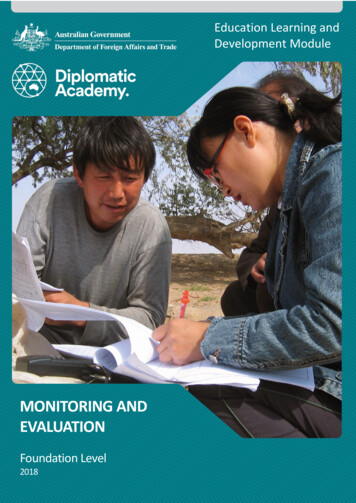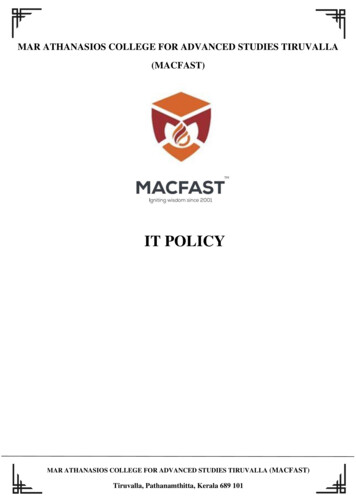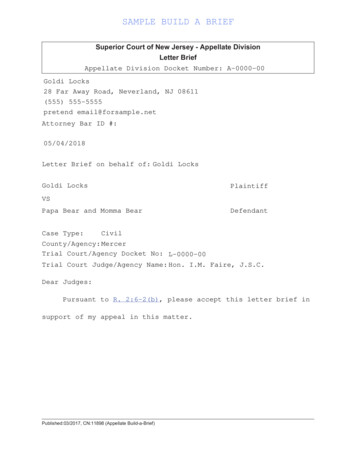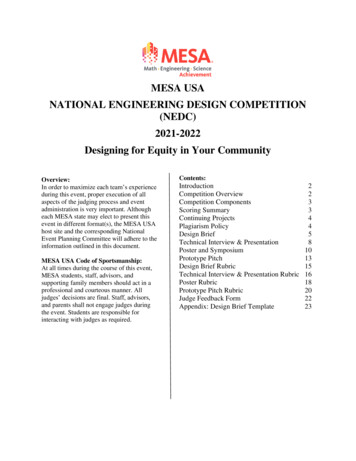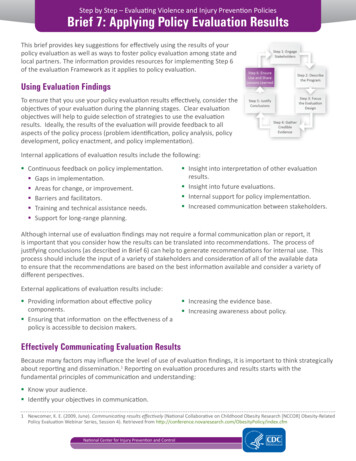
Transcription
Step by Step – Evaluating Violence and Injury Prevention PoliciesBrief 7: Applying Policy Evaluation ResultsThis brief provides key suggestions for effectively using the results of yourpolicy evaluation as well as ways to foster policy evaluation among state andlocal partners. The information provides resources for implementing Step 6of the evaluation Framework as it applies to policy evaluation.Using Evaluation FindingsTo ensure that you use your policy evaluation results effectively, consider theobjectives of your evaluation during the planning stages. Clear evaluationobjectives will help to guide selection of strategies to use the evaluationresults. Ideally, the results of the evaluation will provide feedback to allaspects of the policy process (problem identification, policy analysis, policydevelopment, policy enactment, and policy implementation).Internal applications of evaluation results include the following: Continuous feedback on policy implementation. Gaps in implementation. Areas for change, or improvement. Barriers and facilitators. Training and technical assistance needs. Support for long-range planning. Insight into interpretation of other evaluationresults. Insight into future evaluations. Internal support for policy implementation. Increased communication between stakeholders.Although internal use of evaluation findings may not require a formal communication plan or report, itis important that you consider how the results can be translated into recommendations. The process ofjustifying conclusions (as described in Brief 6) can help to generate recommendations for internal use. Thisprocess should include the input of a variety of stakeholders and consideration of all of the available datato ensure that the recommendations are based on the best information available and consider a variety ofdifferent perspectives.External applications of evaluation results include: Providing information about effective policycomponents. Ensuring that information on the effectiveness of apolicy is accessible to decision makers. Increasing the evidence base. Increasing awareness about policy.Effectively Communicating Evaluation ResultsBecause many factors may influence the level of use of evaluation findings, it is important to think strategicallyabout reporting and dissemination.1 Reporting on evaluation procedures and results starts with thefundamental principles of communication and understanding: Know your audience. Identify your objectives in communication.1 Newcomer, K. E. (2009, June). Communicating results effectively (National Collaborative on Childhood Obesity Research [NCCOR] Obesity-RelatedPolicy Evaluation Webinar Series, Session 4). Retrieved from ndex.cfmNational Center for Injury Prevention and Control
Consider the best frame for your message to meet the communication objectives. Consider the methods you will use to deliver your message. Consider any restrictions on involvement in the policy development process and ensure that you do notviolate them when developing communication objectives and materials.When presenting evaluation results, it is essential that you convey the information in an objective andunbiased manner. This approach can be especially helpful when presenting information that may contradictexisting practice or popular opinion.Figures 1 and 2 present information on the target audience, communication objectives, format and focus, andconsiderations for communicating with two common types of audiences: policymakers and evaluators.Figure 1. Communicating With PolicymakersTarget audiencePolicymakersCommunicationEnsure that policymakers have the best available evidence on a topic available to themobjectiveswhen they are making decisions.Format and focus Use a concise, relatable, and easy-to-understand format such as a one-page policy brief,fact sheet, or a short question-and-answer document.ConsiderationsPolicymakers are often inundated with reports leaving little time for analysis andinterpretation. The following reporting suggestions can facilitate communication withthis critical audience.1,2 Frame data in relation to local context.Provide real-life illustrations to help policy makers relate to the findings.Illustrate statistical data in clear, simple charts and graphs.Present data from case studies or compelling stories.Consider the use of Social Math (presenting data in a contextually relevant format) tomake statistics and numbers meaningful.3If results are mixed or complicated, present them accurately while striving for clearand succinct communication of the major findings.Cost-benefit analyses can be a critical component for demonstrating the economicvalue of a policy.Base information presented on evaluation findings rather than on value-basedrecommendations or suggestions.Present information in an accessible format to assist in translating and transferringinformation.232 CDC, Division of Adolescent and School Health. (2009). Preparing an evaluation report (Evaluation Briefs No. 11). Retrieved from ef11.pdf3 NCIPC. (2008; rev. 2010). Adding power to our voices: A framing guide for communicating about injury. Atlanta, GA: U.S. Department of Healthand Human Services, Centers for Disease Control and Prevention. Retrieved from a.pdf2Step by Step – Evaluating Violence and Injury Prevention Policies
Using Graphics to Convey ResultsGraphics can be a powerful tool for communicating evaluation results. The Extension Program Developmentand Evaluation Program at the University of Wisconsin provides suggestions on how to use graphics to reportevaluation results in their guide Using Graphics to Report Evaluation Results, available at .PDF.Figure 2. Communicating With Colleagues and Other EvaluatorsTarget audienceOther researchers, evaluators, policy peers, academicians, and leading experts in thefield.CommunicationEnsure that evaluation work is credible, replicable, and informs the field of expertise.objectivesGarner support from the scientific community and inform future research andevaluation efforts.Format and focusPrepare a comprehensive and detailed report outlining evaluation processes,methodologies, and outcomes.ConsiderationsWhen planning and drafting a formal evaluation report, it is important to do thefollowing:4,5 Communicate all components in a clear, succinct format, without bias. Provide background information, relevant historical data, and purpose of theevaluation. Include a comprehensive description of the injury or violence prevention policybeing evaluated. Describe the context of the policy—demographics, timeline, and resources. Outline data collection methods, type of data collected, and analysis process. Summarize information about choices made and procedures used during designelection and implementation. Clarify how to use and interpret data, including limitations.45Communicating With PartnersBecause policymakers rely on information and advice from many sources, it is important to include partnersand other stakeholders in dissemination efforts.4 Partners may use evaluation results to influence policydecisions through consistent, targeted messaging via print and electronic media, social marketing tools, thepress, and various other communications methods that can attract the attention of policy makers and theirconstituents.4 However, it is essential that evaluators communicate and disseminate information based on each4 Nelson, S. R., Leffler, J.C., & Hansen, B. A. (2009). Toward a research agenda for understanding and improving the use of research evidence.Portland, OR: Northwest Regional Education Laboratory. Retrieved from http://educationnorthwest.org/webfm send/3115 Brownson R. C., Royer C., Ewing R., & McBride T. D. (2006). Researchers and policymakers: Travelers in parallel universes. American Journal ofPreventive Medicine, 30(2), 164-172.3Step by Step – Evaluating Violence and Injury Prevention Policies
partners’ specific needs and in easy-to-understandformats that can be replicated for other audiences.More information about communicating withpartners is provided in Appendix U.Communicating With the PublicAnother potential audience for policy evaluationresults is the general public. It is critical thatyou identify the purpose and objectives ofcommunication with the public from thebeginning. When developing materials for thegeneral public, make the materials concise andeasy to read. Simple graphics can also be effectivein communicating with the general public.6 Detailsand considerations for communicating with thegeneral public can be found in Appendix U.Making Information AccessibleThe Bloomberg School of Public Health at JohnsHopkins University develops a yearly report titledPreventing Injuries in Maryland: A Resource for StatePolicy Makers. The goals of this document are to raiseawareness about the toll of injury in Maryland, offersolutions to prevent and reduce the burden of injuryin Maryland, and provide contact information for theCenter for Injury Research and Policy and encouragereaders to use the center as a resource. The guidemakes information about evidence-based policies in thefield of injury prevention accessible. It is available d-policy/PolicyResource2012/.Fostering a Culture of Policy EvaluationTo increase the occurrence of policy evaluation among all of the partners in your state, consider the followingsuggestions that can encourage and support policy evaluation. Raise awareness of policy evaluation as a key part of the policy process. Educate partners and decisionmakers on the importance of policy evaluation and on the ways that policy evaluation findings can informthe policy process. Consider ways of implementing policies that will facilitate comparison groups, such asphased roll-outs or pilot projects. Consider policy evaluation methods when creating surveillance and reporting requirements andrecommendations. When refining or developing state data collection systems, consider how the dataelements could potentially support policy evaluations when designing surveillance requirements andrecommendations. Consider implementing mechanisms that facilitate access to datasets across state andlocal agencies. Provide training and technical assistance on basic evaluation and policy evaluation. Conduct presentationsabout the basics of evaluation as well as the key concepts and techniques of policy evaluation. Share thesebriefs with your partners at the state and local levels. Provide information on data sources and methods for accessing data. Provide overviews of existingsurveillance systems and other state and local sources of data. Support peer learning mechanisms and regional networks. Provide a mechanism for partners to shareeffective strategies, ask questions, and brainstorm solutions. Create a repository for policy evaluation results and methodologies. Consider creating a library orrepository of policy evaluation reports in your state. Since many policy evaluations are never formallypublished, it is important to reach out to partners and experts in the field to collect these evaluations andraise awareness about the database.64DuBay, W. H. (2004). The principles of readability. Retrieved from pdfStep by Step – Evaluating Violence and Injury Prevention Policies
Action Steps Consider the goals and objectives of a potential policy evaluation. For each of the goals, identify how theresults of the evaluation can be used to accomplish it. Identify the target audiences and the best mechanisms for reaching them. Assess the existing capacity for conducting policy evaluation at both the state and local levels. Use the resources and tools listed in this brief.Additional ResourcesAdding Power to Our Voices: Framing Guide for Communicating about Injury. Available at a.pdfGateway to Health Communication & Social Marketing Practice (CDC). Available at http://www.cdc.gov/healthcommunication/.The Pink Book—Making Health Communication Programs Work (National Cancer Institute). Available /pinkbook.5Step by Step – Evaluating Violence and Injury Prevention Policies
National Center for Injury Prevention and Control This brief provides key suggestions for effectively using the results of your policy evaluation as well as ways to foster policy evaluation among state and local partners. The information provides resources for implementing Step 6 of the evaluation Framework as it applies to policy evaluation.
